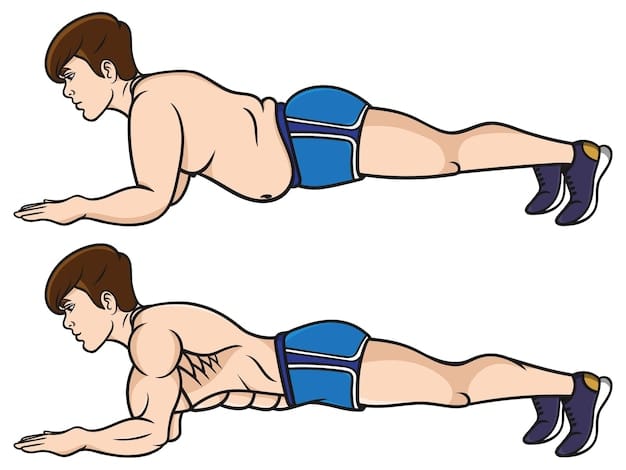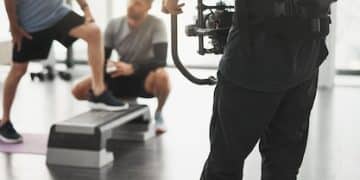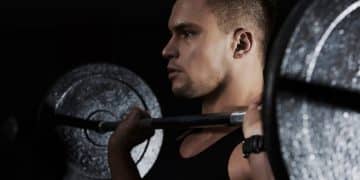6-Week Bodyweight Workout Plan for Beginners: Build Strength Fast

The 6-Week Bodyweight Workout Plan for Beginners provides a structured and progressive regimen designed to build foundational strength, endurance, and fitness using only your body weight, making it accessible and effective for those new to exercise.
Embarking on a fitness journey can feel daunting, but the right starting point makes all the difference. For many, that ideal beginning is the 6-Week Bodyweight Workout Plan for Beginners, a program meticulously designed to introduce you to the fundamentals of strength and conditioning without requiring any specialized equipment. This approach focuses on mastering your own body, building a solid foundation that prepares you for more advanced movements or simply enhances your daily life with newfound vitality and resilience.
Understanding the Power of Bodyweight Training
Bodyweight training, or calisthenics, is a time-honored method of improving physical fitness, relying solely on your own mass for resistance. This form of exercise offers unparalleled versatility and accessibility, making it an excellent choice for beginners. Unlike gym-based routines that might require specific machines or free weights, bodyweight exercises can be performed virtually anywhere, from the comfort of your living room to a park or even a hotel room while traveling. This convenience eliminates common barriers to exercise, such as gym memberships or equipment costs.
The beauty of bodyweight training lies in its emphasis on functional strength. These movements often mimic natural human movements like pushing, pulling, squatting, and lunging. By strengthening your body in these fundamental patterns, you not only improve your muscle mass and endurance but also enhance your balance, coordination, and overall proprioception. This holistic approach means you’re not just building isolated muscles; you’re developing a more resilient and capable body that can tackle everyday challenges with ease.
Benefits of Bodyweight for Beginners
For individuals new to working out, bodyweight training presents a safer and more intuitive way to learn proper form. Without external weights, the risk of injury is significantly reduced, allowing you to focus on mastering the movement patterns before adding resistance. This foundational learning is crucial, as poor form with weights can lead to serious injuries. Bodyweight exercises also engage multiple muscle groups simultaneously, leading to greater caloric expenditure and improved cardiovascular health.
- Minimal equipment needed, often none at all.
- Reduces risk of injury by focusing on proper form.
- Enhances functional strength and mobility.
- Builds a strong core and improves balance.
Moreover, the progressive nature of bodyweight exercises ensures continuous challenge. As you get stronger, you can modify exercises to increase difficulty, such as transitioning from knee push-ups to full push-ups, or from standard squats to pistol squats. This built-in progression keeps the routine engaging and effective, preventing plateaus and fostering a sense of accomplishment as you visibly improve. The mental aspect is equally important; succeeding in bodyweight exercises builds confidence and discipline, essential for sustaining a long-term fitness habit.
The Foundational Principles of the 6-Week Plan
Any effective workout plan, particularly one designed for beginners, must be built on sound principles that ensure safety, effectiveness, and sustainability. The 6-Week Bodyweight Workout Plan for Beginners is structured around progressive overload, consistency, and proper recovery, all tailored to an individual with limited previous experience.
Progressive overload is the cornerstone of muscle growth and strength building. It means gradually increasing the demands placed on your body over time. In a bodyweight context, this isn’t about lifting heavier weights, but rather increasing the number of repetitions, sets, reducing rest times, or advancing to more challenging exercise variations. For instance, you might start with 8 repetitions of an exercise and aim for 10 or 12 in the following weeks, or transition from easier variations to harder ones as your strength improves. This systematic increase in demand forces your muscles to adapt and grow stronger.
Key Elements of Program Design
The plan emphasizes a full-body approach, ensuring that all major muscle groups are worked throughout the week. This balanced training helps prevent muscular imbalances and promotes overall athletic development. Typically, you’ll engage in three structured workout sessions per week, with rest days interspersed to allow for muscle repair and growth. Active recovery, such as light walking or stretching, is encouraged on off-days to aid circulation and flexibility.
- Focus on consistency over intensity initially.
- Incorporate full-body workouts for balanced development.
- Prioritize proper form over number of repetitions.
- Allow adequate rest and recovery between sessions.
Consistency is arguably the most critical component for beginners. Showing up for your workouts, even when motivation wanes, builds the habit and solidifies progress. It’s far better to complete three consistent, moderately intense workouts each week than to attempt one super-intense session followed by a week of inactivity. This plan encourages carving out specific times for exercise, treating them as non-negotiable appointments. Finally, recovery is where your body actually gets stronger. Without adequate sleep, nutrition, and rest, your muscles cannot repair themselves, leading to stagnation or even injury. Listening to your body, adjusting intensity when needed, and prioritizing rest are as crucial as the workouts themselves.
Week-by-Week Breakdown: Building Momentum
The 6-Week Bodyweight Workout Plan for Beginners is designed with a clear progression, gradually increasing the intensity and complexity of exercises while reinforcing foundational movements. Each week builds upon the last, ensuring that your body adapts and strengthens without being overwhelmed. The key is to master the basic movements first, focusing on form, then slowly increase volume and introduce variations.
Weeks 1-2: Foundations and Form. The initial phase is all about learning the core bodyweight movements and establishing proper form. This means slow, controlled repetitions, paying close attention to muscle engagement. Focus on executing each exercise correctly, rather than rushing through reps. You’ll become familiar with movements like squats, push-ups (perhaps knee push-ups), lunges, and planks. The goal here is to create muscle memory and build a baseline level of strength and endurance. Don’t be discouraged if you can’t perform many repetitions; consistency in form is paramount.
Sample Weekly Schedule and Exercises
A typical weekly schedule might involve three full-body workout days, for example, Monday, Wednesday, and Friday, with Tuesday, Thursday, Saturday, and Sunday reserved for rest or active recovery. Each workout session should last between 30-45 minutes, including a warm-up and cool-down.
- Warm-up (5-10 minutes): Light cardio (jumping jacks, high knees) and dynamic stretches (arm circles, leg swings).
- Workout (20-30 minutes): Perform 2-3 sets of 8-12 repetitions for each exercise. Rest 60-90 seconds between sets.
- Cool-down (5 minutes): Static stretches, holding each for 20-30 seconds (hamstring stretch, triceps stretch).
Weeks 3-4: Increasing Volume and Introducing Variations. As your strength and confidence grow, you’ll start to increase the number of repetitions or sets. This is also when you might introduce slightly more challenging variations of exercises, such as transitioning from knee push-ups to incline push-ups, or from standard squats to sumo squats. The focus remains on form, but the intensity begins to ramp up, pushing your muscles closer to their limits. You’ll likely feel stronger and more capable, allowing for a noticeable increase in your work capacity. This is also a good time to perhaps introduce a slightly longer holding time for planks or experiment with variations that challenge your balance.

Weeks 5-6: Advanced Bodyweight Movements and Endurance. The final phase of the plan brings in more complex bodyweight movements or significantly higher volume. This might involve attempting full push-ups, incorporating jumping squats for explosive power, or extending the duration of planks and other holds. The goal is to solidify the strength gained over the past weeks and prepare your body for continued fitness progress. This phase will feel more challenging, but also incredibly rewarding as you realize how far you’ve come. The mental toughness built here will serve you well in any future fitness endeavors.
Essential Exercises for Your Bodyweight Journey
A well-rounded bodyweight routine for beginners includes exercises that target all major muscle groups, ensuring balanced strength development. Each exercise has multiple variations, allowing for progression as you get stronger.
Squats: The Foundation of Lower Body Strength. The squat is a fundamental movement pattern that targets your glutes, quadriceps, and hamstrings. For beginners, mastering the basic bodyweight squat is crucial before moving to more advanced variations. Stand with feet shoulder-width apart, chest up, and core engaged. Lower your hips as if sitting in a chair, keeping your back straight and knees tracking over your toes. Go as deep as comfortable while maintaining good form, then push through your heels to return to the starting position.
Upper Body and Core Staples
For the upper body, push-ups and planks are indispensable. Push-ups work your chest, shoulders, and triceps. Beginners can start with knee push-ups or incline push-ups (hands on a raised surface like a counter or bench) to build strength before progressing to full push-ups on the floor. Maintain a straight line from head to heels, engage your core, and control the movement both down and up. The plank is a static exercise that builds incredible core strength, essential for all other movements. Hold a push-up position, either on your hands or forearms, keeping your body in a perfectly straight line from head to heels, not letting your hips sag or rise too high. Engage your abs tightly.
- Push-ups: Chest, shoulders, triceps, core.
- Plank: Core (abs, obliques, lower back).
- Lunges: Quads, hamstrings, glutes, balance.
- Glute Bridges: Glutes, hamstrings, lower back.
Lunges: Improving Leg Strength and Balance. Lunges challenge each leg individually, improving strength, stability, and balance. Step forward with one leg, lowering your hips until both knees are bent at approximately a 90-degree angle. Ensure your front knee is directly over your ankle and your back knee hovers just above the ground. Push off your front foot to return to standing. Alternate legs. Finally, the glute bridge is excellent for targeting the glutes and hamstrings without putting stress on the lower back. Lie on your back with knees bent and feet flat on the floor close to your glutes. Lift your hips off the ground until your body forms a straight line from shoulders to knees. Squeeze your glutes at the top, then slowly lower down. These exercises, when performed with proper form and consistency, will lay a robust foundation for your fitness journey.
Nutrition and Recovery: Fueling Your Progress
While the 6-Week Bodyweight Workout Plan for Beginners provides the blueprint for physical activity, the success of the program extends far beyond the exercises themselves. Nutrition and recovery are equally, if not more, critical components that determine your progress, energy levels, and overall well-being. Think of them as the silent partners in your fitness journey, constantly working behind the scenes to optimize your results.
Eating for Performance and Repair. Your body needs the right fuel to perform workouts effectively and to repair and rebuild muscle tissue afterward. A balanced diet rich in whole foods is paramount. This includes adequate protein for muscle repair (lean meats, fish, eggs, legumes, tofu), complex carbohydrates for sustained energy (whole grains, sweet potatoes, fruits), and healthy fats for hormone production and overall health (avocados, nuts, seeds, olive oil). Hydration is also non-negotiable; aim to drink plenty of water throughout the day, especially before, during, and after workouts. Staying well-hydrated impacts everything from energy levels to joint lubrication and nutrient transport.
The Importance of Sleep and Active Recovery
Sleep is when your body truly recovers and grows stronger. During deep sleep cycles, growth hormones are released, promoting muscle repair and regeneration. Aim for 7-9 hours of quality sleep per night. Poor sleep can hinder recovery, increase fatigue, and even impact your motivation to exercise. Prioritizing sleep means setting a consistent bedtime and creating a conducive sleep environment, free from distractions.
- Prioritize adequate protein intake for muscle repair.
- Consume complex carbohydrates for sustained energy.
- Ensure healthy fats are part of your daily diet.
- Aim for 7-9 hours of quality sleep nightly.
Active recovery, on the days you’re not doing intense workouts, also plays a vital role. This could involve light walks, gentle stretching, yoga, or foam rolling. These activities help to increase blood flow, reduce muscle soreness, improve flexibility, and enhance overall mobility without adding significant stress to your body. They also serve as a mental break, helping to reduce stress and prevent burnout. Listening to your body is key; if you feel overly fatigued, take an extra rest day. Pushing through extreme discomfort almost always leads to diminishing returns and potential injury. Remember, consistency over intensity is the goal for beginners, and that extends to your recovery practices as well.
By consciously integrating proper nutrition, sufficient sleep, and active recovery into your routine, you are not just working out; you are cultivating a comprehensive lifestyle that supports peak performance and sustainable progress throughout your 6-week plan and beyond.
Overcoming Challenges and Staying Motivated
Beginning a new workout regimen, even one as accessible as bodyweight training, comes with its own set of challenges. From dips in motivation to encountering plateaus, anticipating and preparing for these hurdles can make a significant difference in your ability to complete the 6-Week Bodyweight Workout Plan for Beginners successfully. Staying committed requires a blend of mental fortitude, strategic planning, and self-compassion.
Managing Motivation Fluctuations. It’s unrealistic to expect peak motivation every single day. There will be days when getting off the couch feels like an Olympic feat. On these days, remind yourself of your “why.” Why did you start this plan? Is it for better health, more energy, increased strength, or improved confidence? Reconnecting with your initial motivation can often provide the necessary push. Sometimes, simply starting the warm-up is enough to get into the groove. Setting small, achievable daily or weekly goals, like completing just one more push-up than yesterday or consistently showing up for all three workouts, can also build momentum and a sense of accomplishment.
Strategies for Long-Term Adherence
Tracking your progress is an incredibly powerful motivational tool. Keep a simple workout log where you note the exercises, sets, and repetitions you complete. Seeing your strength and endurance improve over time provides tangible evidence of your hard work and reinforces positive habits. Celebrate small victories, whether it’s completing your first full push-up or holding a plank for an extra 10 seconds. These mini-celebrations acknowledge your effort and keep the journey enjoyable.
- Identify your core motivation and revisit it often.
- Track your progress to visualize improvements.
- Find an accountability partner or community.
- Vary your routine to prevent boredom and plateaus.
Consider finding an accountability partner – a friend, family member, or online community – who shares similar fitness goals. Having someone to share your journey with can provide encouragement, friendly competition, and a sense of responsibility. When facing a plateau, where progress seems to stall, don’t despair. This is a normal part of any fitness journey. It’s often a sign that your body has adapted, and it’s time to introduce new stimuli. This might mean trying new exercise variations, increasing the difficulty of current movements, or incorporating active recovery to aid muscle repair. Finally, remember that consistency doesn’t mean perfection. If you miss a workout, don’t let it derail your entire plan. Simply get back on track with your next scheduled session. Learn from setbacks, adjust as needed, and keep moving forward with a positive mindset.

Beyond the 6 Weeks: Maintaining and Evolving Your Fitness
Completing the 6-Week Bodyweight Workout Plan for Beginners is a significant achievement and a testament to your newfound commitment to fitness. However, this program is not just an endpoint; it’s a powerful springboard for a lifetime of health and physical improvement. The habits, strength, and confidence you’ve built over these six weeks are invaluable assets that can be leveraged to continue your fitness journey, whether you choose to stick with bodyweight training or explore other forms of exercise.
Sustaining Your Bodyweight Practice. If bodyweight training resonates with you, there are countless ways to keep it challenging and engaging. You can continue to progress by mastering more advanced variations of the exercises you’ve learned. For instance, moving from standard push-ups to diamond push-ups or even one-arm push-ups, or from standard squats to pistol squats. You can also increase the overall volume of your workouts, add more complex circuits, or incorporate advanced calisthenics skills like handstands or muscle-ups. Exploring different bodyweight disciplines, such as yoga, Pilates, or gymnastics, can also add variety and introduce new challenges that enhance flexibility, balance, and strength in unique ways.
Expanding Your Fitness Horizons
Should you feel ready to branch out, the foundational strength and body awareness gained from this plan will serve you well in any new activity. Your improved core strength, understanding of movement patterns, and enhanced endurance will make adapting to new exercises or sports significantly easier. You might consider incorporating weights into your routine, joining a gym, taking up running, cycling, swimming, or even trying team sports. The key is to find activities you genuinely enjoy, as enjoyment is a powerful motivator for long-term adherence. Don’t feel pressured to stick to one type of exercise; explore what keeps you engaged and excited.
Regularly reassess your fitness goals. Are you aiming for greater strength, improved cardiovascular health, better flexibility, or simply maintaining your current fitness level? Your goals will evolve, and your training should adapt accordingly. Continue to prioritize proper form, listen to your body, and ensure adequate nutrition and recovery. The most successful fitness journeys are those that are sustainable and adaptable to life’s changes. By approaching fitness as a continuous evolution rather than a destination, you ensure that the benefits of your hard work will endure far beyond these initial six weeks, shaping a healthier, stronger, and more resilient you for years to come.
| Key Aspect | Brief Description |
|---|---|
| 💪 Progressive Overload | Gradually increasing demands (reps, sets, difficulty) over time. |
| 🧘 Proper Form | Crucial for beginner safety and effectiveness before adding intensity. |
| 🍎 Nutrition & Rest | Essential for muscle repair, energy, and overall progress. |
| 📈 Consistency | Key to building habits and seeing sustainable results. |
Frequently Asked Questions About Bodyweight Training
▼
Yes, for beginners, this structured 6-week plan is highly effective for building foundational strength, improving endurance, and enhancing overall fitness. Consistent adherence, combined with proper nutrition and recovery, will yield noticeable results in muscular development and body composition.
▼
The core of this 6-Week Bodyweight Workout Plan for Beginners requires no equipment at all, relying solely on your body’s resistance. While items like a yoga mat for comfort or a sturdy chair for some variations can be helpful, they are not strictly necessary to get started and achieve significant progress.
▼
This plan typically recommends three full-body workout sessions per week, with rest days in between. For example, working out on Monday, Wednesday, and Friday allows for adequate recovery. Consistency is more important than excessive intensity, especially when you are just starting out your fitness journey.
▼
That’s perfectly normal for beginners! The plan incorporates progressive variations. For push-ups, start with knee push-ups or incline push-ups against a wall or counter. For squats, focus on reaching a comfortable depth with good form, even if it’s not a full squat initially. You’ll build strength over time.
▼
Many beginners start feeling stronger and more energetic within the first 2-3 weeks. Visible changes in body composition, such as increased muscle definition or reduced body fat, typically become noticeable within 4-6 weeks when consistently following the plan with good nutrition and adequate rest. Results vary individually.
Conclusion
The 6-Week Bodyweight Workout Plan for Beginners offers a robust and highly accessible pathway into the world of fitness. By focusing on fundamental movements, progressive overload through bodyweight, and emphasizing the crucial roles of nutrition and recovery, this program equips you not just with physical strength but also with the discipline and knowledge to sustain a healthy lifestyle. It demonstrates that significant fitness gains are achievable without fancy equipment, simply through consistent effort and a commitment to mastering your own body. As you complete these six weeks, realize that you’ve built a foundational strength and confidence that will serve as a powerful launching pad for whatever comes next in your personal fitness evolution. Embrace the journey, celebrate your progress, and continue to prioritize your well-being.





